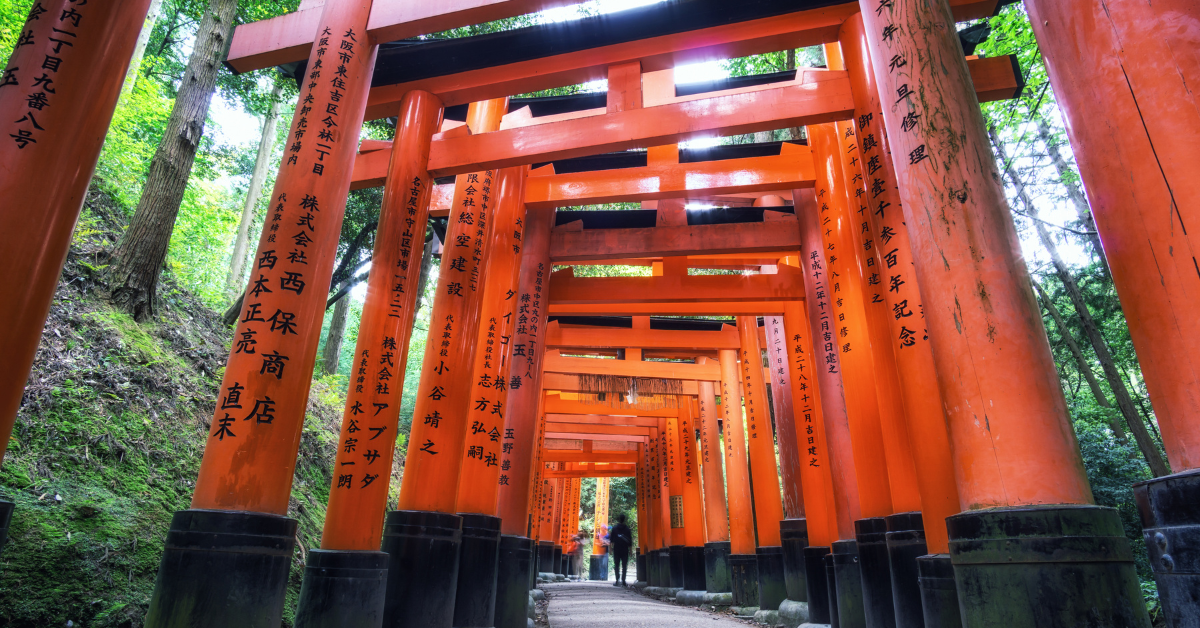Visiting Kyoto offers many opportunities to experience Japanese tradition, but Fushimi Inari Taisha stands out as a spiritual icon known for its stunning vermilion torii gates. Nestled at the foot of Mount Inari, this shrine invites travelers to explore a sacred journey filled with history, nature, and the symbolic presence of fox deities.
The History and Cultural Significance of Fushimi Inari Taisha
Fushimi Inari Taisha was founded in the year 711, making it one of Japan’s oldest and most revered shrines. It serves as the head shrine of over 30,000 Inari shrines across Japan. The main deity worshipped here is Ukanomitama-no-Ōkami, known as the god of agriculture and bountiful harvests. Over time, this faith expanded to include prosperity in business and industry, attracting worshippers from all walks of life.
Throughout the shrine grounds, visitors will find numerous fox statues, regarded as divine messengers. Each fox holds a symbolic item in its mouth—such as a key, scroll, or rice sheaf—each representing a different kind of blessing or divine message.
| Deity | Blessing | Symbol |
|---|---|---|
| Ukanomitama-no-Ōkami | Harvest & Prosperity | Rice Sheaf |
| Satahiko-no-Ōkami | Safe Travel & New Paths | Mirror |
| Ōmiyanome-no-Ōkami | Family & Artistry | Bell |
The Spiritual Allure of the Thousand Torii Gates
The most iconic sight at Fushimi Inari Taisha is the path of a thousand vermilion torii gates, also known as Senbon Torii. In reality, there are over 10,000 gates, each donated by individuals or businesses as a prayer or expression of gratitude. These gates create a sacred tunnel, symbolizing the transition from the mundane to the divine. The vivid vermilion color is believed to ward off evil and purify the spirit.
The gates take on different appearances depending on the time of day. In the morning, the path is serene and bathed in soft light, while in the evening, the interplay of shadow and sunset creates a mystical atmosphere.
| Feature | Detail |
|---|---|
| Total Torii Gates | Over 10,000 |
| Symbolic Color | Vermilion (for purification and protection) |
| Donation Cost | Small: ~¥170,000 / Large: ~¥1.3 million |
| Best Photo Times | 6:00–8:00 AM / 4:00–6:00 PM |
Mount Inari Pilgrimage and Spiritual Trail Highlights
The shrine experience extends beyond the main hall. The entire Mount Inari is considered sacred, and visitors can follow a pilgrimage trail that spans about 4 kilometers. This path, lined with mini shrines and sacred stones, offers a quiet, reflective journey for those who undertake it.
The Yotsutsuji viewpoint, located halfway up, offers breathtaking panoramic views of Kyoto city. As one ascends further, the trail becomes steeper and quieter, enhancing the sense of spiritual seclusion. The journey through nature and tradition provides a rare opportunity to connect deeply with Japanese spirituality.
| Item | Description |
|---|---|
| Trail Length | About 4 km |
| Time Required | Around 2–3 hours |
| Highlight | Yotsutsuji Panoramic View |
| Recommended Gear | Comfortable shoes, water, hat |
Fox Worship and Popular Omamori (Charms) & Ema (Votive Plaques)
Another unique aspect of Fushimi Inari Taisha is its deep-rooted fox worship. Believed to be divine messengers, these foxes are often seen guarding shrines, each symbolizing different blessings. This belief is celebrated through the popular fox-faced ema, where visitors draw unique expressions and write their wishes.
Also popular are the omamori, or protective charms, which are often bought as souvenirs or spiritual tokens. These charms cater to various needs—from business success to academic achievement, and even safe childbirth. Among the most memorable experiences is lifting the “omokaru ishi”, or “heavy-light stone,” to divine whether a wish will come true.
| Item | Purpose | Feature |
|---|---|---|
| Business Charm | Business success | Golden fox design |
| Study Charm | Exam success | Ideal for students |
| Safe Birth Charm | Childbirth protection | Gentle pastel fabric |
| Omokaru Stone | Wish fortune | Weight indicates outcome |
Access and Visiting Tips
Fushimi Inari Taisha is easily accessible, located just a 5-minute train ride from Kyoto Station. Visitors can get off at JR Inari Station, which is right in front of the shrine’s entrance. The Keihan Main Line also provides access via Fushimi Inari Station, a short walk away.
Due to the popularity of the site, it is best to visit early in the morning or late in the afternoon to avoid large crowds. If planning to hike the mountain trail, wear non-slip shoes and bring water, especially during hot weather. During winter, dress warmly, as the mountain path can be quite chilly.
| Station | Travel Time | Distance |
|---|---|---|
| JR Inari Station | About 5 min | Next to shrine |
| Keihan Fushimi Inari Station | About 10 min | Walking distance |
| From Kyoto Station | 5 min via JR | Direct access |
Conclusion
Fushimi Inari Taisha is more than just a sightseeing spot. It embodies the spirit of Japanese culture, spirituality, and natural beauty. From the iconic torii gates and sacred mountain paths to the symbolism of foxes and traditional charms, every element of this shrine invites introspection and wonder.
For international travelers, it’s a rare chance to experience authentic Japanese religious practice in a serene, open, and photogenic environment. Whether you’re seeking luck, reflection, or cultural enrichment, Fushimi Inari Taisha offers an unforgettable journey that goes far beyond the ordinary.






